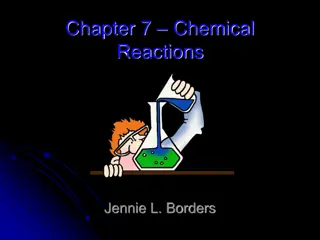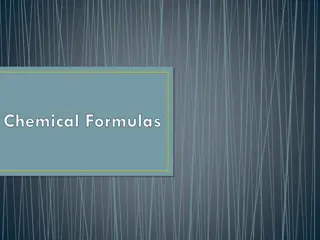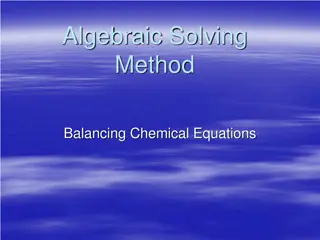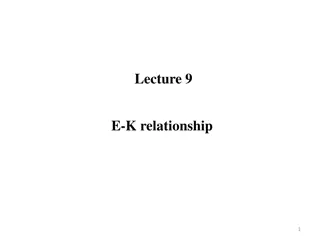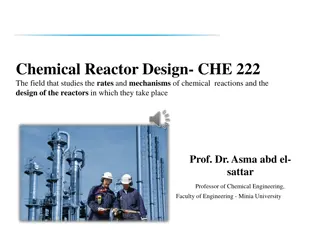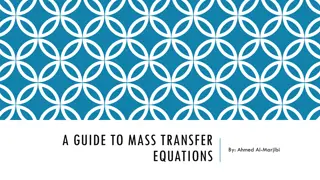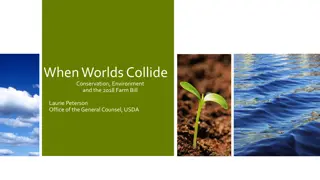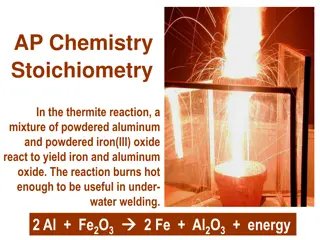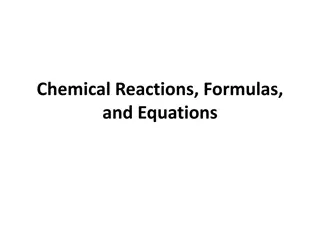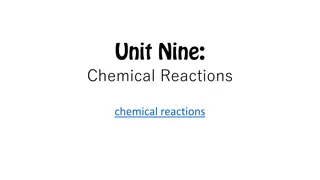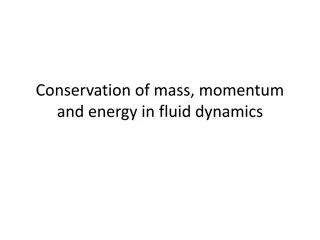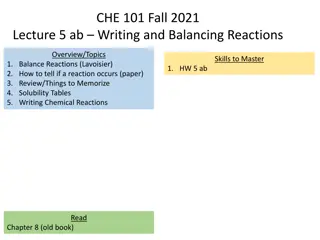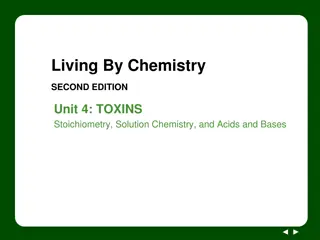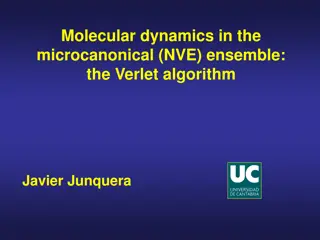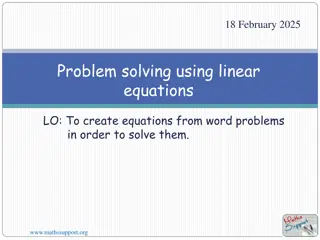Balancing Chemical Equations and Conservation of Mass
Explore the concept of balancing chemical equations and conservation of mass through examples and challenges. Learn about the number of atoms in compounds and practice balancing symbol equations. Discover the law of conservation of mass and its application in chemical reactions. Challenge yourself with constructing balanced equations and understanding reactant-product relationships.
Download Presentation

Please find below an Image/Link to download the presentation.
The content on the website is provided AS IS for your information and personal use only. It may not be sold, licensed, or shared on other websites without obtaining consent from the author.If you encounter any issues during the download, it is possible that the publisher has removed the file from their server.
You are allowed to download the files provided on this website for personal or commercial use, subject to the condition that they are used lawfully. All files are the property of their respective owners.
The content on the website is provided AS IS for your information and personal use only. It may not be sold, licensed, or shared on other websites without obtaining consent from the author.
E N D
Presentation Transcript
CWK BALANCING EQUATIONS DO NOW ACTIVITY: Describe the number of atoms in each compound e.g. NH3 has 1 nitrogen and 3 hydrogen atoms 1. MgF2 2. CuSO4 3. Al(OH)3 4. K2CO3 5. Ca(NO3)2 1 magnesium and 2 fluorine atoms 1 copper, 1 sulfur and 4 oxygen atoms 1 aluminium, 3 oxygen and 3 hydrogen atoms 2 potassium, 1 carbon and 3 oxygen atoms 1 calcium, 2 nitrogen and 6 oxygen atoms Challenge: Construct the formula for silver (I) sulfate
Progress indicators GOOD PROGRESS: - State what is meant by conservation of mass - Balance symbol equations OUTSTANDING PROGRESS: - Use the law of conservation of mass to calculate missing reactants or products
Word consciousness Conservation remains the same (e.g. mass in a reaction)
Which way would the see-saw tilt, and why? O O H H O O H H H H
Conservation of Mass Mass is neither created nor destroyed during chemical processes. It is conserved. Antoine Lavoisier Old School Chemist
Balance these (if needed); 1. _HCl + _CaCO3 _CaCl2 + _CO2 + _H2O 2. _Zn + _H2O _ZnO + _H2 3. _Na + _H2O _NaOH + _H2 4. _Fe2O3 + _C _CO2 + _Fe 5. _Mg + _H2O _MgO + _H2 6. _HCl + _Ca _CaCl2 + _H2 7. _Na + _H2SO4 _Na2SO4 + _H2 8. _Al + _Cl2 _AlCl3 9. _Al + _O2 _Al2O3 10._Mg + _HNO3 _Mg(NO3)2 + _H2 Remember you can only place numbers in front of the elements/ compounds, not in the middle of the formulae. Challenge: Butene (C4H8) reacts with oxygen (O2) to form carbon dioxide and water. Construct a balanced symbol equation
SELF-ASSESS IN RED 1. HCl + CaCO3 CaCl2 + CO2 +H2O 2. Zn + H2O ZnO + H2 3. Na + H2O NaOH + H2 4. Fe2O3 + C CO2 + Fe 5. Mg + H2O MgO + H2 6. HCl + Ca CaCl2 + H2 7. Na + H2SO4 Na2SO4 + H2 8. Al + Cl2 AlCl3 9. Al + O2 Al2O3 10.Mg + HNO3 Mg(NO3)2 + H2 2 2 2 Already balanced 2 2 2 2 4 3 3 Already balanced 2 2 2 4 3 3 2 2 2 Challenge: Butene (C4H8) reacts with oxygen (O2) to form carbon dioxide and water. Construct a balanced symbol equation C4H8 + 6O2 4CO2 + 4H2O
Calculating the mass of reactants or products If 20 g of sodium reacts with 40 g of oxygen, how much sodium oxide will be produced? 4Na + O2 2Na2O 20 g 40 g ? 60 g Mass of reactants = 60 g You cannot create or destroy mass in a reaction so the mass of product(s) must be the same as the mass of the reactants
Example 2 45 g of ethene reacts with oxygen to produce 30 g of water and 40 g of carbon dioxide. How much oxygen reacted in this reaction? C2H4 + 3O2 2CO2 + 2H2O 45 g ? 40 g 30 g Mass of products = 70 g Mass of reactants = 70 g Mass of oxygen = 70 g 45 g = 25 g
Calculate the missing values 2 H2 + O2 2 H2O 10 g 15 g ? 1. 25 g CH4 + 2 O2 CO2 + 2 H2O 20 g 40 g 45 g ? 2. 15 g CH4 + 2 O2 CO2 + 2 H2O 100 g ? 110 g 40 g 50 g 3. 2 Fe2O3 + 3 C 3 CO2 + 4 Fe 300 tonnes 75 tonnes 140 tonnes ? 4. 235 tonnes 2 Fe2O3 + 3 C 3 CO2 + 4 Fe 2000 tonnes ? 900 tonnes 1500 tonnes 400 tonnes 5.
Exam question A student heats 2.5 g of hydrate copper sulfate in a test tube. 0.9 g of water is given off. The remaining solid is anhydrous copper sulfate. (d) produced. Calculate the mass of anhydrous copper sulfate 2.5 0.9 __________________________________________________ __________________________________________________ 1.6 Mass of anhydrous copper sulfate = __________________ g (2)
Plenary 1.a) 5.4 g of magnesium reacts with 2.8 g of fluorine, what is the mass of the product produced? 8.2 g b) Write a balanced symbol equation for this reaction Mg(s) + F2(g) MgF2(s) 2.) 100 kg of aluminium reacts with 120 kg of hydrochloric acid a) If 40 kg of hydrogen was produced, what was the mass of the other product? Name the product in your answer b) Write a balanced symbol equation for the reaction with state symbols 2Al(s) + 6HCl(aq) 180 kg, aluminium chloride 2AlCl3(aq) + 3H2(g)


